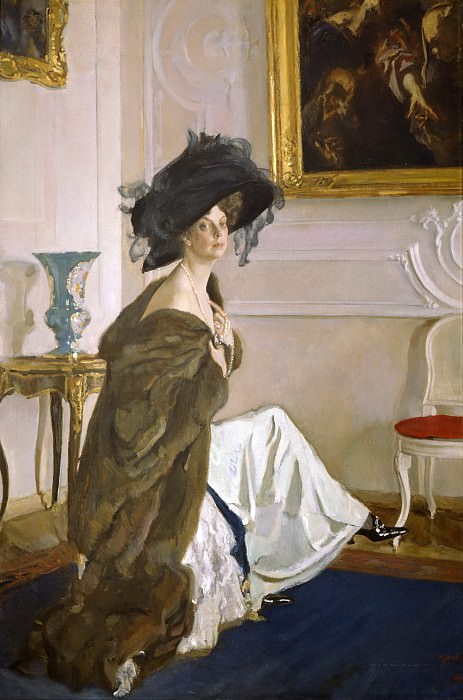Portrait of Princess Olga Orlova Valentin Serov (1865-1911)
Valentin Serov – Portrait of Princess Olga Orlova
Edit attribution
Download full size: 2116×3200 px (1,3 Mb)
Painter: Valentin Serov
Location: State Russian Museum, St. Petersburg (Государственный Русский Музей).
The artist manages to write a very effective portrait of the princess. He created it in the last year of his life. This painting is one of the painter’s greatest creative achievements. Much attention on the canvas is given to the beautifully decorated interior. Serov depicts the luxurious hall of the palace, which belongs to Princess Orlova. As you know, this woman was known to be an incredibly fashionable lady.
Description of Valentin Serov’s painting "Portrait of Princess Orlova".
The artist manages to write a very effective portrait of the princess. He created it in the last year of his life. This painting is one of the painter’s greatest creative achievements.
Much attention on the canvas is given to the beautifully decorated interior. Serov depicts the luxurious hall of the palace, which belongs to Princess Orlova.
As you know, this woman was known to be an incredibly fashionable lady. That is why Serov pays maximum attention to her dress. Duchess depicted in a deliberately picturesque pose. Impressed by the splendor of furs and the glitter of luxury jewelry. The heroine of the portrait shows respectability. She is haughtily arrogant.
Serov aspires to style. A special solution in terms of plasticity is striking. Very subtle painting in terms of coloring is surprising. All this is aimed at fully revealing the essence of the heroine in psychological terms. This woman was famous for her very extravagant behavior.
The princess was not beautiful. She was not distinguished by any special talents. But her special taste and elegance, as well as her enormous fortune, did their work. She was a very famous lady in St. Petersburg. Many artists dreamed of painting her portrait. She wrote more than once. Serov was no exception.
Contemporaries treated this portrait in different ways. Some he liked it. Others were sure that the artist is ironic and even sarcastic. But today we know about the existence of Princess Orlova only because of this portrait.
It is worth noting not only the merits of the picture in terms of painting. It can become a kind of manual. The modern viewer can imagine what was possible at the beginning of the 20th century. The princess is dressed in a silk dress with a frank neckline.
A fur stole completes the outfit. At the beginning of the 20th century, the skirts became narrow. Therefore, they had to shorten them. That’s why maximum attention was paid to stockings and shoes.
Serov manages to create a really lively portrait.
Кому понравилось
Пожалуйста, подождите
На эту операцию может потребоваться несколько секунд.
Информация появится в новом окне,
если открытие новых окон не запрещено в настройках вашего браузера.
You need to login
Для работы с коллекциями – пожалуйста, войдите в аккаунт (open in new window).




















You cannot comment Why?
The setting appears to be an opulent interior, suggested by the gilded frame of a painting on the wall and the ornate side table holding a decorative vase. The rich blue carpet underfoot grounds the composition, while the warm, diffused lighting lends a soft glow to the scene. The overall impression is one of aristocratic composure and a hint of mystery, as the princess gazes with a discerning and perhaps introspective expression.
The subtext of the painting lies in its portrayal of wealth, status, and the public persona of nobility. The fur, pearls, and elaborate hat are clear indicators of her privileged position. However, the slight turn of her head and her direct, yet somewhat reserved, gaze suggest a person with depth and inner world, transcending mere material possessions. The interplay of light and shadow contributes to a subtle dramatic effect, hinting at the complexities that might lie beneath the polished exterior of the princess. The composition, with its dynamic angles and rich textures, invites the viewer to contemplate not just the subjects appearance, but also her character and the era she represents.